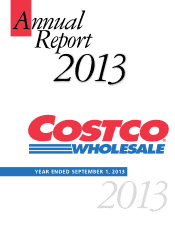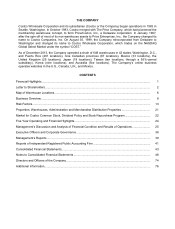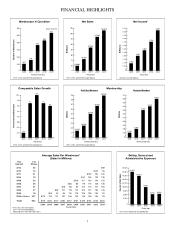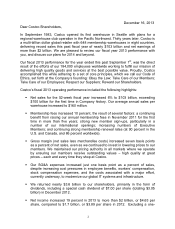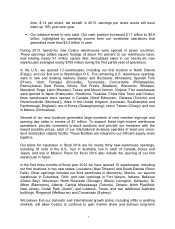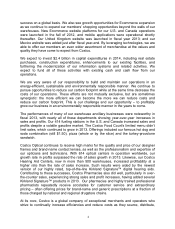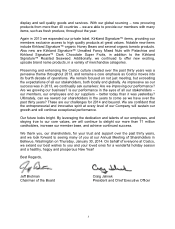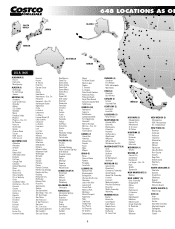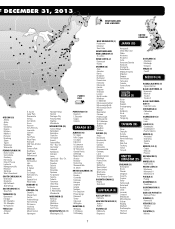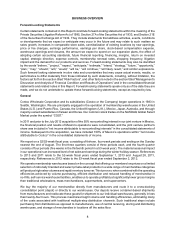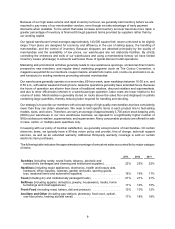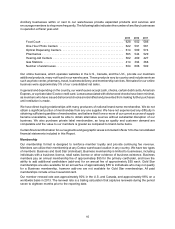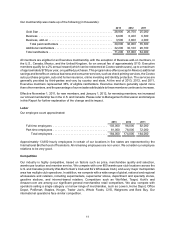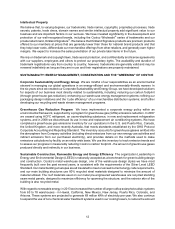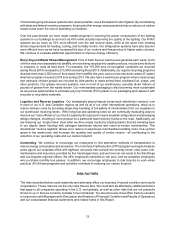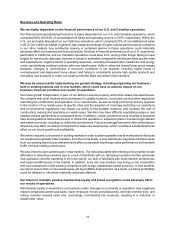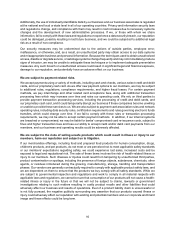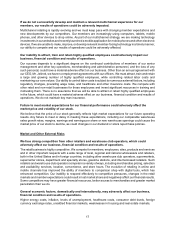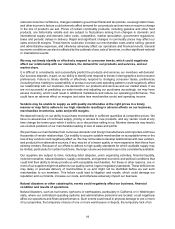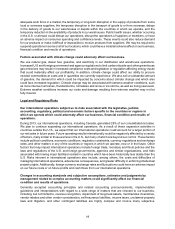Costco 2013 Annual Report Download - page 11
Download and view the complete annual report
Please find page 11 of the 2013 Costco annual report below. You can navigate through the pages in the report by either clicking on the pages listed below, or by using the keyword search tool below to find specific information within the annual report.
9
Because of our high sales volume and rapid inventory turnover, we generally sell inventory before we are
required to pay many of our merchandise vendors, even though we take advantage of early payment
discounts when available. To the extent that sales increase and inventory turnover becomes more rapid, a
greater percentage of inventory is financed through payment terms provided by suppliers rather than by
our working capital.
Our typical warehouse format averages approximately 143,000 square feet; newer units tend to be slightly
larger. Floor plans are designed for economy and efficiency in the use of selling space, the handling of
merchandise, and the control of inventory. Because shoppers are attracted principally by the quality of
merchandise and the availability of low prices, our warehouses are not elaborate facilities. By strictly
controlling the entrances and exits of our warehouses and using a membership format, we have limited
inventory losses (shrinkage) to amounts well below those of typical discount retail operations.
Marketing and promotional activities generally relate to new warehouse openings, occasional direct mail to
prospective new members, and regular direct marketing programs (such as The Costco Connection, a
magazine we publish for our members, coupon mailers, emails from costco.com, costco.ca, and costco.co.uk,
and handouts) to existing members promoting selected merchandise.
Our warehouses generally operate on a seven-day, 69-hour week, open weekdays between 10:00 a.m. and
8:30 p.m., with earlier weekend closing hours. Gasoline operations generally have extended hours. Because
the hours of operation are shorter than those of traditional retailers, discount retailers and supermarkets,
and due to other efficiencies inherent in a warehouse-type operation, labor costs are lower relative to the
volume of sales. Merchandise is generally stored on racks above the sales floor and displayed on pallets
containing large quantities, thereby reducing labor required for handling and stocking.
Our strategy is to provide our members with a broad range of high quality merchandise at prices consistently
lower than they can obtain elsewhere. We seek to limit specific items in each product line to fast-selling
models, sizes, and colors. Therefore, we carry an average of approximately 3,700 active stock keeping units
(SKUs) per warehouse in our core warehouse business, as opposed to a significantly higher number of
SKUs at discount retailers, supermarkets, and supercenters. Many consumable products are offered for sale
in case, carton, or multiple-pack quantities only.
In keeping with our policy of member satisfaction, we generally accept returns of merchandise. On certain
electronic items, we typically have a 90-day return policy and provide, free of charge, technical support
services, as well as an extended warranty. Additional third-party warranty coverage is sold on certain
electronic item purchases.
The following table indicates the approximate percentage of annual net sales accounted for by major category
of items:
2013 2012 2011
Sundries (including candy, snack foods, tobacco, alcoholic and
nonalcoholic beverages and cleaning and institutional supplies) . . . . . . . . . . 22% 22% 22%
Hardlines (including major appliances, electronics, health and beauty aids,
hardware, office supplies, cameras, garden and patio, sporting goods,
toys, seasonal items and automotive supplies) . . . . . . . . . . . . . . . . . . . . . . . 16% 16% 17%
Food (including dry and institutionally packaged foods) . . . . . . . . . . . . . . . . . . 21% 21% 21%
Softlines (including apparel, domestics, jewelry, housewares, media, home
furnishings and small appliances) . . . . . . . . . . . . . . . . . . . . . . . . . . . . . . . . . 11% 10% 10%
Fresh Food (including meat, bakery, deli and produce) . . . . . . . . . . . . . . . . . . 13% 13% 12%
Ancillary and Other (including gas stations, pharmacy, food court, optical,
one-hour photo, hearing aid and travel) . . . . . . . . . . . . . . . . . . . . . . . . . . . . . 17% 18% 18%

